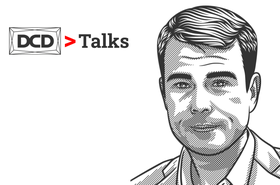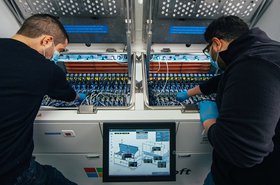When it comes to achieving sustainability in the data center, public discord can make it difficult for operators to rise above the noise. Even what it means to be ‘sustainable’ is inconsistently defined, which only serves to muddy the waters further.
We decided we needed an authority on the subject, so DCD sat down with CBRE, to find out the what, why, and how of sustainable success in the data center. But first thing’s first, what does it all actually mean? The CBRE team offered definitions for some of the key vocabulary to establish baseline principles.
Sustainability: The avoidance of the depletion of resources (environmental, social, or cultural) in order to maintain a balance. It is meeting the needs of the present without compromising the ability of future generations to meet theirs.
Environmental Social Governance (ESG): Using environmental, social, and governance factors to evaluate companies and countries on their level of advancement as it relates to sustainability. The Global Reporting Initiative (GRI) provides the world’s most widely used standards for sustainability reporting.
Science-Based Targets initiative (SBTi): Emissions reductions targets adopted by companies to reduce greenhouse gas (GHG) emissions are considered “science-based” if they are in line with the level of decarbonization required to keep global temperature increase below 2°C compared to pre-industrial temperatures, as described by the Intergovernmental Panel on Climate Change (IPCC).
Scope 1 emissions: Scope 1 emissions are direct GHG emissions that occur from sources that are controlled or owned by an organization (e.g., emissions associated with fuel combustion in boilers, furnaces, vehicles).
Scope 2 emissions: Indirect GHG emissions associated with the purchase of electricity, steam, heat, or cooling. Although scope 2 emissions physically occur at the sites where they are generated, they are accounted for in an organization's GHG inventory because they are a result of the organization's energy use.
Scope 3 emissions: Emissions that are the result of activities from assets not owned or controlled by the reporting organization but impact the organization’s value chain. Scope 3 emissions include all sources not within an organization's scope 1 and 2 boundary.
Decarbonization: Starting with a baseline performance year, decarbonization is the long term (and permanent) removal of carbon (scope 1, 2 and 3 emissions) from every element of an organization’s value chain. Through this removal, a target performance year, aligned with an organization’s ambitions and goals, is set to track ongoing progress towards full removal of GHG emissions as implementation of solutions occurs, as defined by CBRE.
Carbon neutral: Achieving a balance of carbon dioxide emissions with equal amount of CO2 removal through the application of market-based tools such as Renewable Energy Certificates (RECs), Power Purchase Agreements (PPAs) and/or carbon offsets.
Net-zero: Achieving a scale of value chain emission reductions consistent with the depth of abatement achieved in pathways that limit warming to 1.5°C with no or limited overshoot. Neutralizing the impact of any source of residual emissions that cannot feasibly be eliminated by permanently removing an equivalent amount of atmospheric carbon dioxide.
“From our perspective sustainability all begins with data integrity. That means measuring resource consumption, whether it’s energy or water. Measuring greenhouse gas emissions and commitments that may have been made for energy efficiency, green power, recycling, and waste management, to name a few,” says Ross Oakley, global director, energy and sustainability, CBRE.
This definition, centered on data integrity (data that is accurate, complete, and consistent) is very much shaped by the current drivers for sustainability. And although it would be nice to think the catalyst for greener data centers was the future of our beloved planet, public image, as well as benefits to the bottom line are certainly motivating factors.
“Companies are becoming more and more aware that their take on ESG is increasingly impactful in their shareholders' investment decisions. This has spurred many of our clients to react and adopt ambitious carbon reduction goals," says Ryan Carter, global energy and sustainability account director at CBRE.
This heightened investor scrutiny, combined with new regulations mandating greater transparency and public disclosure of emissions in certain geographies, has companies clamoring for change faster than any climate crisis ever could. And to make matters a bit more complicated, different geographies mean different regulations.
“Here in the US there's one ruling that looks like it could have a gigantic impact, and that is the Securities and Exchange Commission (SEC) ruling that may require companies to disclose their greenhouse gas emissions and climate-related risks that can impact their business,” says Oakley.
“Due to our global footprint at CBRE, we have to make sure that we understand what sort of legislation is moving through which governments, where they are, and the status and impact of that legislation.”
This kind of knowledge is invaluable to organizations looking to achieve their ESG goals (or actually set some). Without it, they not only risk non-compliance, but costly reputational damage.
So, what can companies do to prevent this?
“There's always a concern around public opinion that spurs companies to adopt frameworks that add credibility to their ambitious carbon reduction goals, such as the Science Based Targets initiative (SBTi) framework,” says Carter.
Targets are considered ‘science-based’ if they are aligned with what the latest climate science deems necessary to meet the goals of the Paris Agreement, such as limiting global warming to below 2°C above pre-industrial levels and pursuing efforts to limit warming to 1.5°C.
Roughly 39 percent of global CO2 emissions are generated from the built environment and 28 percent come from facility operations. The best science we have tells us we need to limit global temperature increase to 1.5 degrees Celsius to mitigate the most extreme effects of climate change. Decarbonization is a solution to reverse this trend, otherwise we will cross the point of no return in 10 years if we emit more than 500 gigatons (GT) of CO2 emissions.
Both CBRE and its key clients have net-zero goals in line with the SBTi framework. Working with these goals helps cut through the aforementioned noise, encompasses all mission Scopes, 1, 2 and 3 and provides a clearly defined pathway for companies to reduce greenhouse gas emissions.
Interestingly, it isn’t just this framework, or customers that have spurred clients into action.
Despite one of CBRE's global IT clients having procured an impressive 85 percent of its energy from renewable sources as of this year, employee engagement surveys have revealed that their employee base is still asking for more, in the form of on-site solar. This serves to highlight that the pressure to implement sustainable practices is not only coming from potential investors, stakeholders, and customers, but from workforces demanding real progress from their employers.
This amalgamation of customer and employee feedback, alongside the use of the SBTi framework, indicates that a siloed approach to sustainability won’t be sufficient and a holistic, forward-looking strategy is now a necessity.
“We’ve definitely seen a switch in the industry from, say, certifying buildings or seeking individual pieces of equipment towards a more holistic view,” says Carter.
“There was once a time when there was a budget for seeking a certification or a plaque on the wall of a facility, whereas now the goal is the much larger, more meaningful, more ambitious target of net-zero. That goal now determines what the budget is going to be.”
Work with what you’ve got
So, with a newfound understanding of local regulations, and a set of clearly defined ESG goals for your data center in line with the SBTi, now you have to achieve them. But how?
The advent of new technology, like AI, automation, and innovative cooling techniques may suggest a solution to every challenge, but upgrading can be expensive and isn’t always the best solution.
“There's quite often an opportunity to optimize existing equipment and building materials and make the most use out of current systems before leaping to the next technology, which would be part of your Scope 3 emissions,” says Carter.
“It’s important to ensure we're making the most out of the materials we have currently available, rather than extracting new virgin materials. Although there is a need for early adopters to drive the technological solutions to climate change, all too often blatant greenwashing is entirely ignored, with high priority given to the marketability of the new and shiny rather than focusing on the ultimate goal of decreasing life cycle emissions.”
Looking at the long-term lifecycle cost of these projects, rather than a short-term focus on simple payback, will not only make data centers more valuable and more efficient, but presents them as a far sounder investment for potential buyers if they were ever to be sold.
And the bottom line is what it all boils down to. Despite the fact we’re trending in the right direction, spiking energy costs, particularly in the EU, have meant operators have had to become even more aggressive when it comes to reducing operational costs. With companies spending millions of dollars per month on energy, CBRE is uniquely positioned to help its clients understand that energy is a controllable cost and can offer practical advice on how to manage it.
CBRE takes a holistic approach that considers every asset in the portfolio and its alignment with client decarbonization target performance goals. Utilizing portfolio decarbonization solutions, CBRE demystifies the journey to carbon abatement for clients, with the goal of reaching net-zero carbon emissions or better.
Once goals have been identified, CBRE will create a decarbonization roadmap for clients with clear actions and measurable outcomes. With a project management team of more than 10,000, CBRE can also help clients implement these strategies at scale quickly and affordably.
“Every client is in a different place on their decarbonization journey. We meet them where they are at today, orchestrate where they want to be in the future with their stakeholders, and provide services with solutions to reach their future target performance goals. This allows our clients to focus on their core business while we focus on their ESG and decarbonization efforts,” says Sarah Spencer-Workman, global director of decarbonization at CBRE.
Back to basics
With cooling accounting for anywhere between 40 to 60 percent of a data center operator’s total energy bill, cooling is a good starting point for reducing operational costs and optimizing energy usage. However, you need to be able to walk before you can run and CBRE can help ensure the correct process is followed.
“We need to ensure all the basics are taken care of first. The first step is measuring PUE. The next step is optimizing air flow, preventing hot and cold air from mixing, and eliminating hot spots. The final step is turning up temperatures – basically allowing the whitespace to reach higher temperatures without exceeding any client SLAs,” says Oakley.
Then and only then can you start exploring other solutions. For instance, CBRE suggests maximizing your building management system via the optimal placement of sensors to ensure it has the ability to grab more data points. Once accurate data has been captured, the opportunity to optimize by introducing new technology tools becomes available.
For those just starting out on their sustainability journey or others who might be at an impasse with their current strategy, CBRE’s dedicated team of experts are on hand to help educate clients on what it will take to meet their goals and help identify the areas of highest opportunity across the portfolio.
Once you’re on the road to green, you will soon see the impact and competitive edge a sustainable operation provides. Not only in relation to the bottom line, but the ability to attract and retain new talent, customers, and investors who are looking for those truly committed to sustainable data centers both now and in the future, greenwashers need not apply.
To find out more about CBRE's data center services click here.
More from CBRE
-

DCD>Talks Management & Operations with Colin Delacy, CBRE
Dive into management & operations with this DCD>Talk from our live DCD>Connect Silicon Valley event
-

-

Why mission-critical tech innovation is important to CBRE
And they decided to sponsor the DCD award

